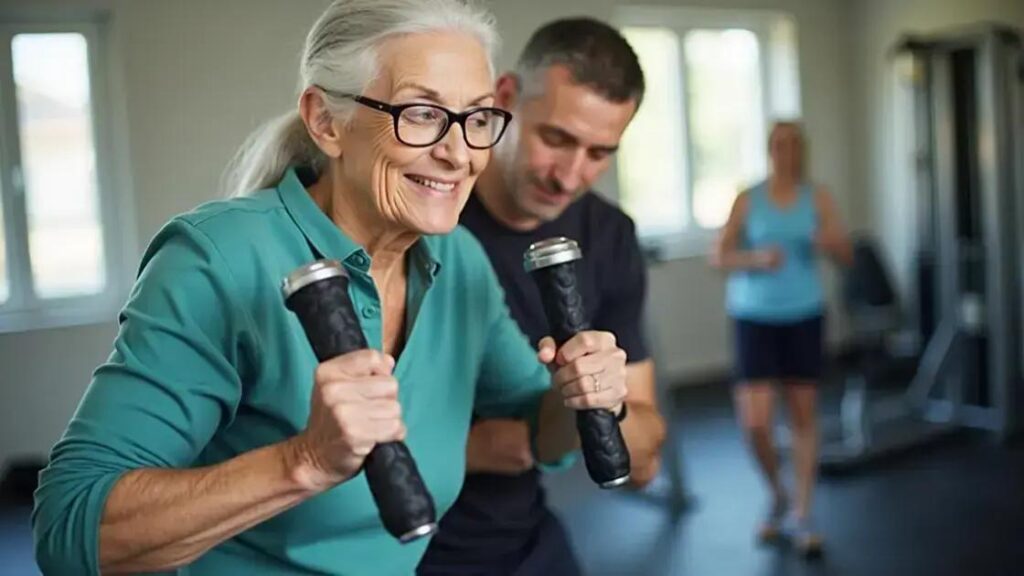To avoid workout injuries after 50, focus on understanding the impact of aging on exercise, recognizing common injuries, and implementing preventative measures such as proper warm-ups, low-impact exercises, and maintaining hydration. In case of injury, follow the RICE method and seek professional guidance for recovery.
As we age, maintaining an active lifestyle becomes crucial, but understanding how to avoid workout injuries after 50 is equally important. Injuries can deter us from exercising, leading to a decline in health and fitness. By learning the common injuries that occur in this age group and implementing effective preventative measures, you can continue to enjoy the benefits of exercise safely. This article will discuss key insights on staying injury-free and keeping your workouts enjoyable and effective.
Understanding Aging and Its Impact on Exercise

As we grow older, our bodies undergo a variety of changes that can impact how we exercise. Understanding these changes is crucial for maintaining an effective fitness routine and avoiding injuries.
Physical Changes with Age
One of the most significant changes is the decrease in muscle mass, known as sarcopenia, which can start as early as our 30s. This loss of muscle not only affects strength but also balance, making falls more likely. Additionally, joints can become stiffer due to a decrease in cartilage, leading to discomfort during physical activities.
Metabolism and Recovery
Our metabolism tends to slow down with age, which affects how we burn calories and recover from workouts. Older adults may find it takes longer to recover from both workouts and injuries. This is why it’s important to incorporate more rest and recovery time into your exercise routine.
Mental Aspects of Aging
Cognitive factors also play a role in how we approach exercise. Motivation and mental focus can diminish over time, but staying engaged in physical activities is essential for both physical and mental health. Finding enjoyable activities can enhance motivation and make workouts feel less like a chore.
Adapting Your Workout Routine
To minimize the risk of injury, it’s essential to adapt your workout routine to accommodate the physiological changes. This may include focusing more on low-impact exercises, flexibility training, and resistance training to help maintain muscle mass. Understanding your body’s signals and adjusting your routine accordingly can lead to a fitter, healthier lifestyle after 50.
Common Workout Injuries for Those Over 50

Understanding the common workout injuries for those over 50 can help you take preventative steps to stay safe while exercising. Older adults are more susceptible to certain injuries due to physical changes, decreased strength, and flexibility.
1. Strains and Sprains
Muscle strains and ligament sprains are frequent injuries that can occur during physical activities. Lower back strains and ankle sprains are particularly common. These injuries usually happen when the body is pushed beyond its limits, especially during activities that require sudden movements or heavy lifting.
2. Joint Issues
As we age, our joints may develop arthritis or experience wear and tear. This can lead to joint pain, especially in the knees, hips, and shoulders. Osteoarthritis is the most common form, and it can be aggravated by high-impact exercises.
3. Tendon Injuries
Tendonitis, an inflammation of the tendons, is common among older adults. The Achilles tendon and shoulder tendons are often affected. This injury can result from repetitive strain or overuse, especially with activities that involve running or lifting overhead.
4. Fractures
Fractures, particularly hip fractures, are a serious concern for older adults. Falls are often the cause of these types of injuries. It’s important for those over 50 to engage in balance and strength training to reduce the risk of falls.
By recognizing these common injuries and their causes, you can take proactive measures to avoid them, ensuring a safer workout experience and a healthier lifestyle.
Preventative Measures for Safe Workouts

To ensure safe workouts for those over 50, it is vital to implement preventative measures. These strategies can help reduce the risk of injuries and keep you active and healthy.
1. Start with a Warm-Up
A proper warm-up is essential to prepare your muscles and joints for exercise. A warm-up increases blood flow and flexibility. Consider doing light aerobic exercises or dynamic stretches for about 10-15 minutes prior to your workout.
2. Choose Appropriate Exercises
Focus on low-impact exercises that are easier on the joints. Activities like swimming, cycling, or walking can provide excellent cardiovascular benefits without the stress that higher-impact workouts can impose.
3. Listen to Your Body
Pay close attention to how your body feels during and after exercise. If you experience pain or discomfort, it’s crucial to stop and assess the situation. Ignoring bodily signals can lead to serious injuries.
4. Stay Hydrated
Hydration is key for optimal physical performance, especially as we age. Make sure to drink enough water before, during, and after your workouts to keep your joints lubricated and muscles functioning properly.
5. Incorporate Strength Training
Building muscle strength can help protect your joints. Incorporate resistance training into your fitness routine at least twice a week. Focus on major muscle groups, using light weights or resistance bands.
6. Cool Down After Exercise
Cooling down gradually helps your body return to its resting state. Spend 5-10 minutes doing light stretching or walking after your workouts to prevent stiffness and promote flexibility.
By using these preventative measures, you can create a safer workout environment and reduce the chances of injuries as you age.
Best Practices for Recovering from Injuries

Recovering from injuries requires thoughtful practices to ensure a safe return to activity. Here are some best practices for recovering from injuries effectively.
1. Follow the RICE Method
The RICE method stands for Rest, Ice, Compression, and Elevation. Use this approach right after an injury occurs to reduce swelling and pain. Rest the injured area, apply ice packs for 15-20 minutes, use compression wraps to minimize swelling, and elevate the injury to decrease inflammation.
2. Consult a Healthcare Professional
Always consult a doctor or physical therapist for a proper assessment of your injury. They will provide a specific recovery plan and guide you through safe rehabilitation exercises.
3. Gradually Increase Activity
Once approved by a professional, start by gently introducing movement to the injured area. Gradually increase the intensity and duration of your workouts, listening to your body’s feedback to avoid re-injury.
4. Balance Rest and Activity
Finding the right balance between rest and activity is essential. While you need to give your body time to heal, light exercises as recommended by a healthcare professional can promote circulation and aid recovery.
5. Focus on Nutrition
A healthy diet rich in protiens, vitamins, and minerals can aid recovery. Foods high in omega-3 fatty acids, antioxidants, and calcium can help repair tissues and strengthen bones.
6. Stay Positive and Patient
Recovery can often be a slow process. It’s important to maintain a positive attitude and be patient with yourself. Emotional well-being plays a significant role in physical recovery.
By following these best practices, you can ensure a more effective recovery from injuries and prepare yourself for a successful return to your workout routine.
In Summary: Staying Safe and Active After 50
Maintaining an active lifestyle after 50 is vital for overall well-being, but it comes with the responsibility of preventing injuries. Understanding the impact of aging on exercise, recognizing common injuries, and implementing preventative measures are essential steps for safety.
Should an injury occur, knowing best practices for recovery can make all the difference in getting back to your workout routine. Remember to prioritize strength training, flexibility exercises, and proper warm-up techniques to support your body through its natural changes.
With the right knowledge and approach, you can continue to enjoy a fulfilling and active life without compromising your health.
FAQ – Frequently Asked Questions About Avoiding Workout Injuries After 50
What are some common workout injuries for those over 50?
Common injuries include strains, sprains, joint issues, tendonitis, and fractures, often resulting from physical changes as we age.
How can I prevent injuries while exercising?
Incorporate warm-ups, choose low-impact exercises, listen to your body, stay hydrated, and gradually increase activity levels.
What should I do if I sustain an injury?
Follow the RICE method (Rest, Ice, Compression, Elevation) and consult a healthcare professional for a proper assessment and recovery plan.
What role does nutrition play in recovery from injuries?
A well-balanced diet with proteins, vitamins, and minerals is crucial for tissue repair and improving overall recovery speed.
How important is rehabilitation for recovering from injuries?
Rehabilitation is essential to restore function, strength, and movement, allowing a safe return to normal activities and preventing re-injury.
Are there specific exercises I should focus on as I recover?
Emphasize gentle stretching, low-impact cardio, and strength training exercises tailored to your recovery needs as advised by a professional.












